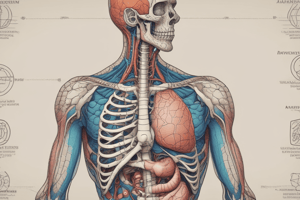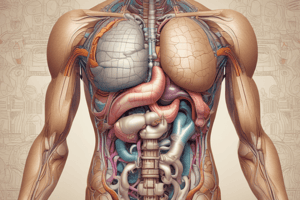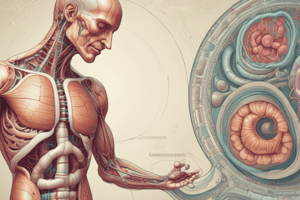Podcast
Questions and Answers
What is the first basic process of the digestive system?
What is the first basic process of the digestive system?
- Motility
- Digestion
- Ingestion (correct)
- Secretion
Which organ is NOT part of the digestive canal?
Which organ is NOT part of the digestive canal?
- Stomach
- Esophagus
- Large intestine
- Liver (correct)
What is the role of secretion in the digestive system?
What is the role of secretion in the digestive system?
- To move food through the digestive canal
- To release water, acid, buffers, and enzymes into the lumen (correct)
- To break down food into smaller molecules
- To absorb nutrients from food
Which process involves the movement of food toward the anus?
Which process involves the movement of food toward the anus?
Which accessory organ is involved in secreting bile?
Which accessory organ is involved in secreting bile?
What process is responsible for breaking down food into small molecules?
What process is responsible for breaking down food into small molecules?
What overall function do the organs of the digestive canal serve?
What overall function do the organs of the digestive canal serve?
What is the total amount of secretion produced by digestive organs?
What is the total amount of secretion produced by digestive organs?
What is the function of the Upper Esophageal Sphincter?
What is the function of the Upper Esophageal Sphincter?
Which part of the pharynx is responsible solely for respiration?
Which part of the pharynx is responsible solely for respiration?
Where does the esophagus begin its passage?
Where does the esophagus begin its passage?
What is located at the opening on the diaphragm that the esophagus passes through?
What is located at the opening on the diaphragm that the esophagus passes through?
Which function is NOT associated with the oropharynx?
Which function is NOT associated with the oropharynx?
What do the submandibular glands secrete?
What do the submandibular glands secrete?
What substance primarily covers the dentin of the tooth crown?
What substance primarily covers the dentin of the tooth crown?
What is the primary function of cement in teeth?
What is the primary function of cement in teeth?
At what age do deciduous teeth typically begin to erupt?
At what age do deciduous teeth typically begin to erupt?
How many deciduous teeth do humans usually have?
How many deciduous teeth do humans usually have?
How many permanent teeth do humans have on average?
How many permanent teeth do humans have on average?
What is the length of the esophagus approximately?
What is the length of the esophagus approximately?
What type of muscle composes the tongue?
What type of muscle composes the tongue?
Which function is NOT associated with the submandibular glands?
Which function is NOT associated with the submandibular glands?
What divides the tongue into symmetrical lateral halves?
What divides the tongue into symmetrical lateral halves?
What is the primary function of the inner sheet of the muscular layer in the digestive canal?
What is the primary function of the inner sheet of the muscular layer in the digestive canal?
What type of muscle constitutes the muscular layer of the digestive canal?
What type of muscle constitutes the muscular layer of the digestive canal?
What term is used to describe the material eliminated from the digestive canal?
What term is used to describe the material eliminated from the digestive canal?
Which layer is found deep to the muscular layer of the digestive canal?
Which layer is found deep to the muscular layer of the digestive canal?
What is the role of the myenteric neural plexus?
What is the role of the myenteric neural plexus?
What is the composition of the serosa layer in the digestive canal?
What is the composition of the serosa layer in the digestive canal?
What action is primarily facilitated by the longitudinal fibers of the muscular layer?
What action is primarily facilitated by the longitudinal fibers of the muscular layer?
During which process does the body eliminate feces?
During which process does the body eliminate feces?
Which layer of the digestive canal is responsible for the actual absorption of nutrients?
Which layer of the digestive canal is responsible for the actual absorption of nutrients?
What type of muscle contractions occur in the digestive canal?
What type of muscle contractions occur in the digestive canal?
What is the deepest layer of the digestive canal called?
What is the deepest layer of the digestive canal called?
Which of the following is NOT a component of the mucosa?
Which of the following is NOT a component of the mucosa?
What is the largest serous membrane in the body?
What is the largest serous membrane in the body?
What does the myenteric neural plexus primarily control?
What does the myenteric neural plexus primarily control?
Which layer of the esophagus serves as its superficial layer?
Which layer of the esophagus serves as its superficial layer?
What are the two types of peritoneum mentioned?
What are the two types of peritoneum mentioned?
The connective tissue layer of the mucosa is called what?
The connective tissue layer of the mucosa is called what?
Which type of tissue forms the epithelium layer in the mucosa?
Which type of tissue forms the epithelium layer in the mucosa?
What role does the peritoneum play regarding the abdominal organs?
What role does the peritoneum play regarding the abdominal organs?
What type of connective tissue does the esophagus lack?
What type of connective tissue does the esophagus lack?
Study Notes
Digestive System Overview
- The digestive system breaks down food into smaller molecules for cellular use.
- Comprised of two organ groups: the digestive canal (GI tract) and accessory digestive organs.
Basic Processes of the Digestive System
- Ingestion: Involves taking food and liquids into the mouth.
- Secretion: Around 7 liters of water, acid, buffers, and enzymes are secreted into the digestive canal by cells.
- Motility: Smooth muscle contractions facilitate the mixing and movement of food toward the anus.
- Digestion: Breaks down food into small molecules; occurs in the mouth, stomach, and intestines.
- Defecation: The elimination of waste (feces) from the body via the anus.
Structure of the Digestive Canal
- Continuous tube from the esophagus to the anus; segments include the esophagus, stomach, small intestine, large intestine, and anal canal.
- Composed of four layers (from deep to superficial):
- Mucosa: Innermost layer, a mucous membrane with epithelium, connective tissue (lamina propria), and smooth muscle (muscularis mucosae).
- Submucosa: Contains blood vessels, lymphatics, and nerves.
- Muscular Layer: Two sheets of smooth muscle (circular and longitudinal) assist in motility; the myenteric neural plexus controls movement.
- Serosa: The outer layer; a serous membrane that suspends parts of the digestive canal in the abdominal cavity; the esophagus has an outer adventitia instead.
Peritoneum
- The largest serous membrane; supports abdominal organs, contains blood and lymph vessels, and nerves.
Enteric Nervous System (ENS)
- Consists of motor and sensory neurons; includes myenteric and submucosal plexuses for controlling digestive actions.
Accessory Digestive Organs
- Teeth: Comprised of dentin (internal structure), enamel (outer crown), and cement (roots); two dentitions: deciduous (20) and permanent (32).
Tongue
- Accessory organ made of skeletal muscle; forms the floor of the oral cavity; consists of symmetrical lateral halves divided by a median septum.
Esophagus
- A muscular tube (~25 cm long) connecting the throat to the stomach; it is collapsible and passes behind the trachea.
- Key structures include:
- Esophageal Hiatus: Opening in the diaphragm.
- Upper Esophageal Sphincter: Controls movement from the pharynx to the esophagus.
- Lower Esophageal Sphincter: Regulates movement into the stomach.
Pharynx
- Funnel-shaped tube extending from the nasal cavity to the esophagus; has three parts:
- Nasopharynx: Functions in respiration only.
- Oropharynx: Involved in swallowing and respiration.
- Laryngopharynx: Connects to the esophagus.
Stomach
- A J-shaped organ that connects the esophagus to the small intestine, located inferior to the diaphragm.
Studying That Suits You
Use AI to generate personalized quizzes and flashcards to suit your learning preferences.
Description
This quiz covers the basic processes and functions of the digestive system, detailing how organs work together to break down food into smaller, usable molecules. Understand the key functions such as ingestion and other essential processes involved in digestion.




